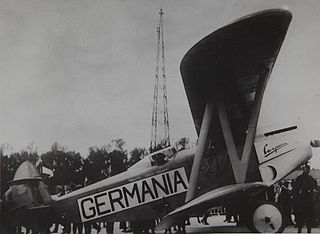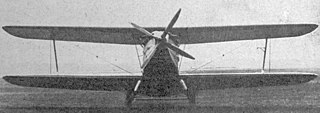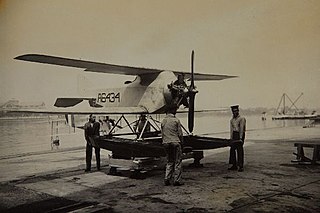
The Caspar C 32 was an aircraft developed in Germany for aerial spraying in the late 1920s. It was a single-bay biplane with staggered, equal-span wings that accommodated the pilot and a single passenger or observer in tandem open cockpits. A small, additional horizontal stabiliser was fitted near the top of the tall single tail fin above the main horizontal stabiliser.

The Caspar C 35 Priwall was a German airliner of the late 1920s, of which only a single example was built. It was a large, single-engine, single-bay biplane of conventional configuration with fixed tailskid undercarriage. The staggered, equal-span wings were braced with a large I-strut. Not only were the passengers seated within a fully enclosed cabin, but the flight deck was fully enclosed as well.

The Focke-Wulf A 20 Habicht was an airliner developed in Germany in the late 1920s. It was a high-wing cantilever monoplane with fixed tailskid undercarriage. The fuselage was deep and seated four passengers in a fully enclosed cabin. The type was not bought by the airlines and only a few examples were built.

The Caspar U.1 was a 1920s German patrol seaplane designed by Ernst Heinkel and built by Caspar-Werke. The U.1 was designed to fit into a cylindrical container to allow it to be carried, then launched from a submarine.

The Elias EC-1 Aircoupe was an American two-seat parasol wing monoplane designed and built by Elias of Buffalo, New York.
The Zeppelin-Lindau C.II was a German single-engine two-seat biplane built by Zeppelin-Lindau during World War I.
The Caspar C 30, aka Caspar LE 30 was an aerial reconnaissance aircraft developed in Germany and built in Denmark in the late 1920s.
The Caspar C 36 was an aircraft developed in Germany for aerial reconnaissance in the late 1920s.
The Caspar C 23 was a sports aircraft developed in Germany in the mid-1920s.
The Caspar C 24 was a sports aircraft developed in Germany in the mid-1920s.
The Caspar C 26 was a sports aircraft developed in Germany in the mid-1920s.
The Caspar C 27 was a training seaplane aircraft developed in Germany in the late 1920s.
The Caspar C 23 was a sports aircraft developed in Germany in the mid-1920s.
The Caspar CT 1 was a sports aircraft developed in Germany in the early 1920s.
The Caspar U 2 was a recce floatplane built for Japan in the 1920s.
The Caspar CJ 14 was a German fighter aircraft built in the 1920s.
The Caspar CS 14 was a German fighter aircraft built in the 1920s.
The Caspar CLE 11 was an airliner built in Germany in the early 1920s.
The Caspar CLE 16 was an airliner built in Germany in the early 1920s.
The Caspar CLE 12 was an airliner built in Germany in the early 1920s.





